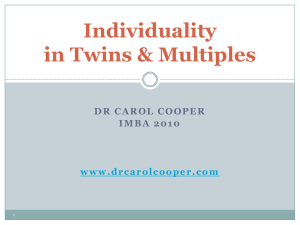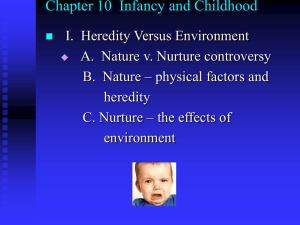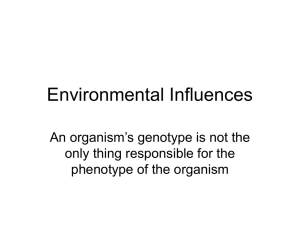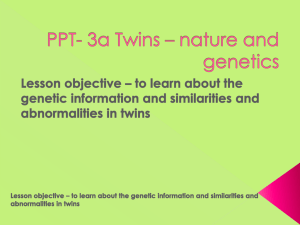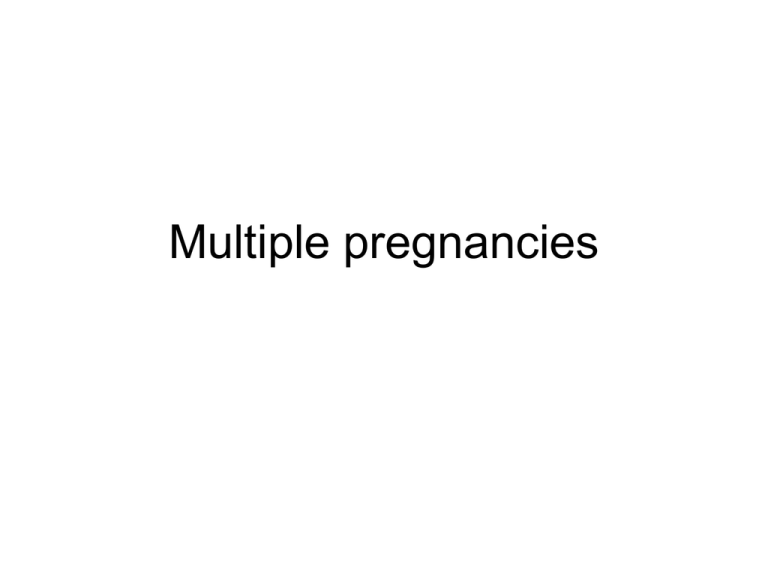
Multiple pregnancies
• Definition
Pregnancies resulting in the birth of more
than one neonate at a time are graded as
multiple pregnancies.
• Types of multiple pregnancies
• Multiple pregnancies may be
–mono-ovular (identical) or
–poly-ovular (fraternal)
• Mono-ovular multiple pregnancies result
from fertilization of a single ovum that will
later on split into two.
• They are also called mono-zygotic type of
multiple pregnancies.
• The embryos, fetuses and neonates
resulting from a mono-zygotic pregnancy
are called mono-zygotic (Identical) twins.
• In other words twins resulting from one
zygote are mono-zygotic twins.
• These twins will share 100% same DNA,
• They have the same hand and footprints
and
• Yet have different teeth marks and
fingerprints.
• Poly-ovular multiple pregnancies result
from fertilization of more than one
secondary oocyte.
• They are usually di-zygotic type of multiple
pregnancies.
• But it may be tri-zygotic type, tetra-zygotic
and so on.
• Dizygotic twins come from two different
secondary oocytes, each fertilized by two
different sperms.
• That mean they share only 50% of their
DNA, much like all other singleton siblings.
• They can be the same or opposite sexes.
• They can as dissimilar as some singleton
siblings.
• But
• They can look like identical twins, very
rarely.
• The embryos, fetuses and infants resulting
from a di-zygotic pregnancy are called dizygotic twins.
• In other words twins resulting from two
zygotes are di-zygotic twins.
• They are also called fraternal twins.
• They are almost two third of twin
pregnancies.
• The frequency of di-zygotic twins shows
marked racial differences
• but
• The incidence of monozygotic twins is
almost the same in all populations.
• The frequency of di-zygotic twins
increases with maternal age
• but
• The incidence of monozygotic twins is not
affected with maternal age.
• The fetal membranes and placentas vary
according to the origin of the twins.
• When more than two fetuses co-exist,
• they may come from one secondary
oocyte or
• May come from more than one secondary
oocyte or
• be the result of combined mono-ovular
and poly-ovular twining.
• About 25% of identical twins are mirror
image twins.
• Their hair falls in opposite directions,
• They have mirror image fingerprints
• If one is right handed, the other is left
handed.
• Half identical twins occur when one
secondary oocyte splits into two ootids
before fertilization.
• Each ootid is then fertilized by a separate
sperm.
• These twins share 75% of their DNA as
they share the same DNA from ootids and
different DNA from each sperm.
• The incidence of multiple pregnancies has
increased in these days due to excessive
use of exogenous gonadotrophins.
• These drugs are given to women with
ovulatory failure who are treated for
infertility.
• Conjoined ("Siamese") twins are those that are
attached at birth.
Craniopagus
Pyopagus
Thoraco-abdominopagus
• Conjoined twins can be separated from
each other if they have no vital parts in
common.
• For example in craniopagus if the brain
tissue is common it will be very difficult to
separate the conjoined twins.
• But if the two brains are separate and only
the skull cavities communicate it will be
easy to separate the two babies from each
other.
• Multiple pregnancies have higher risks of
fetal morbidity and mortality than single
pregnancies
• Morbidity:
• Morbid means diseased or unhealthy.
• Morbidity is the condition of being
diseased.
• It is the sick rate.
• It is the ratio of sick to well persons in a
community.
• Mortality:
• Mortal means subject to death or destined
to die.
• Mortality is the quality of being mortal or
the death rate.
• The fetal morbidity and mortality
progressively increases as the number of
fetuses increases.
• Study of twins is important in human
genetics. It is useful for comparing the
effects of genes and environments on the
development of insan (human being)
•
Are there signs that determine whether a
woman is more likely to have twins? Yes.
1. Women who are of above average height
and who have a large bone structure are
more likely to have twins.
2. Women who give birth at an older age
(30+)
3. Women who have taken fertility drugs
4. Women who have been on birth control
for several years.
5. Women who were fraternal twins
themselves, the chances of their having
twins increase fivefold.
Di-zygotic twins
• Poly-ovular multiple pregnancies result
from fertilization of more than one
secondary oocyte.
• They are usually di-zygotic type of multiple
pregnancies.
• But it may be tri-zygotic type, tetra-zygotic
and so on.
• The embryos, fetuses and infants resulting
from a di-zygotic pregnancy are called dizygotic twins.
• In other words twins resulting from two
zygotes are di-zygotic twins.
• Di-zygotic twins result from simultaneous
shedding of two secondary oocytes and
fertilization by two different sperms.
• The resulting two zygotes have totally
different genetic constitutions.
• They share only 50% of their DNA, much
like all other singleton siblings.
• They can be the same or opposite sexes.
• The infants born are not identical to each
other.
• They may be two brothers or two sisters or
one sister and one brother.
• So they have no more resemblance than
any other sisters or brothers born at
different times.
• The only thing they have in common is
that they were in their mother’s uterus at
the same time.
• They were womb-mates.
• They are also called fraternal (brotherly)
twins.
• The two zygotes implant independently.
They have their own placentae, amnions
and chorionic sacs.
• In approximately 40% cases the
implantation of two zygotes is very close;
the two placentas are thus so close that
they may fuse together.
• Similarly the walls of the chorionic sacs
may also appose each other and fuse.
• Occasionally, di-zygotic twins posses red
blood cells of two different types,
indicating that the fusion of two placentas
was so close that red blood cells were
exchanged.
• This is called erythrocyte mosaicism.
• The incidence of di-zygotic twins is 7 to 11
per thousand births.
• Approximately two-thirds of twins are dizygotic twins.
• Di-zygotic twins show hereditary tendency.
• The tendency of di-zygotic twins to repeat
in families is evidence of hereditary
influence.
• This is a photograph of Mr Liaqat with his
two dizygotic twin daughters. They are
sitting in the lap of their father. Saba
Liaqat is on right side (the side of her
grandmother) and Ayesha Liaqat is on left
side.
• Saba Liaqat is blackish while Ayesh is
whitish in color. Ayesha was born half hour
before Saba.
• A photograph of dizygotic sisters, Saba and
Ayesha. Both are five year old in this
photograph. Saba is one and half inch taller
than Ayesha.
• The incidence rate of di-zygotic twins
increases with maternal age.
• The frequency of di-zygotic twins shows
marked racial differences.
• Asians 1 in 500.
• Caucasians 1 in 125.
• Africans 1 in 20.
• The recurrence risk in families is about
three times than in general population.
• If the first born are di-zygotic twins, the
chances of twining or some other form of
multiple births are approximately five times
more in next pregnancy than in general
population.
• Studies show that the genotype of mother
affects the frequency of di-zygotic twins,
but the genotype of father has no effect on
the frequency of di-zygotic twins.
• Genotype: The entire genetic constitution
of an individual.
• Two secondary oocytes.
• Two blastocysts have developed from two
zygotes.
• Each blastocyst implant separately. Each has
its own placenta, amniotic cavity and chorionic
cavity
• The two blastocysts may implant like Ayat
9 i.e. both with cephalic presentation.
• They may implant like Ayat 10 i.e. one with
cephalic presentation and other with
breach presentation.
• Note in Ayat 9 and 10 placentas, chorions
and amnions are separate.
• The two blastocysts may implant like Ayat
11 i.e. both with cephalic presentation.
• They may implant like Ayat 12 i.e. one with
cephalic presentation and other with
breach presentation.
• Note in Ayat 11 and 12 the two placentas
and chorionic sacs are fused but the
amnions are separate.
Mono-Zygotic Twins
• Mono-ovular multiple pregnancies result
from fertilization of a single ovum. They
are also called mono-zygotic type of
multiple pregnancies.
• The embryos, fetuses and infants resulting
from a mono-zygotic pregnancy are called
mono-zygotic twins. In other words twins
resulting from one zygote are monozygotic twins.
• Mono-zygotic twins are always of the
same sex. They will be either two sisters
or two brothers.
• They are genetically identical and very
similar in external appearance.
• If they are exposed to similar
environments they produce similar results.
• Physical differences between monozygotic twins are environmentally induced.
• I remember my two female students in
Army medical college.
• Now Dr Ayeshah and Dr Javairiah.
• They were mono-zygotic twins.
• Their handwriting was very similar.
• They used to secure almost equal marks.
• They result from splitting of the zygote at
various stages of development.
• The earliest separation is believed to
occur at two to eight cell stages.
• Here the zygote splits and form two
separate identical zygotes.
• They develop into two morulas and then
into two blastocysts.
• The two blastocysts implant separately.
• Each developing embryo has its own
placenta and chorionic sac.
• Although the arrangement of membranes
and placentas of these twins resembles
the membranes and placentas of dizygotic twins yet these twins can be
recognized as partners of a mono-zygotic
pair by their strong resemblance in blood
groups, fingerprints, eye color, hair color,
and external appearance.
• And they are always of the same sex.
• ALLAH may split the developing zygote at
early blastocyst stage, around the end of
first week.
• The embryoblast is divided into two groups
of cells, resulting in two embryoblasts
within the same blastocyst cavity.
• The two developing embryos have a single
common placenta and single common
chorionic cavity but separate amniotic
cavities.
• The placenta is called monochorionicdiamniotic twin placenta.
• In rare cases the separation occurs at
bilaminar disc stage, before the
appearance of primitive streak.
• In this case the two developing embryos
have a single common placenta, a single
common chorionic sac and a single
common amniotic sac. Although the twins
share a single common placenta yet the
blood supply is usually well balanced.
• The incidence of mono-zygotic twins is 3
to 4 per thousand births.
• The type of membranes and placentas
formed depends on when the twining
process started.
Separation
Two Cell
Stage
Splitting of Zygote
Early Blastocyst
Stage
Bilaminar Germ Disc
Stage
•
•
•
•
Saim and Sarim are two brothers.
They are monozygotic twins.
They were born on 2000.
They are sons of Dr Sadia Rasheed.
• Look at the two pictures.
• Look at the identical response Saim and
Sarim in both pictures.
• Saim and Sarim driving magic car.
•
•
Observations of Dr Sadia (the mother of
Saim and Sarim) regarding her
monozygotic twins
If one suffers from fever, the other
monozygotic brother is bound to get
fever.
• Once a louse was found in the head of
Saim.
• I checked the head of Sarim and found
similar louse their also.
• Both have similar handwriting.
• But their behaviors are quite different from
each other.
• Look at the picture
• Saim and Sarim came to me along with
their mother.
• I presented two bottles of cola for them.
• Sarim immediately took the bottle but
Saim did not. He took rooh afza from his
bottle and drank it.
• He was afraid of cough but Sarim was not
in spite of the instructions from his mother.
•
•
•
•
Dr Sadia says
Saim is sober, never fight.
Sarim is aggressive, always beats Saim.
If there is one toffee Saim will not take it,
Sarim will take it.
• If father says, “I will beat you”. Saim
becomes afraid but Sarim not.


